World famous sea kayaker and author, Gordon Brown, has said that the best one day paddle in the world is from Elgol to Loch Scavaig (Loch Coruisk) in the heart of the Cuillins, on the south coast of Skye. I was surprised by this as he has paddled to Les Ecrehous, on a number of occasions, a superb day trip from Jersey.
I might be biased, as this paddle is so close to my home, but it is a paddle which I still enjoy and am eager to complete at every opportunity. Les Ecrehous is an area that I have grown to know over the years. The small islets have all the ingredients of superb sea kayaking, strong cross currents, a beautiful destination with fine views of Jersey and France and one of the best benches in the world on which to sit and eat a packed lunch.

At low water they cover an area of around 4 square kilometres but as the tide rises their size shrinks significantly, with the tide running fast through the exposed islets and heads. The sovereignty of this small area has been contested numerous times with the issue finally being settled at the International Court of Justice at The Hague in 1953, a case which also involved Les Minquiers. Jurisdiction was granted to Jersey.
In 1993 and 1994 there were French “invasions” of the reef, when people landed from Normandy. On the 24th June 1993, 8 fishing boats landed about 50 men who took down the Union Flag and replaced it with the Tricolour and the banner of Normandy. They left after about 40 minutes, taking the Union Flag with them.
In 1994 the invasion had received greater publicity, with posters appearing in ports along the Normandy coast. Saturday 9th July saw a force of of 30 police officers and 5 honorary police stationed on the Ecrehous. Approximately 150 French citizens landed on the reef, ranging from a priest who celebrated Mass, to some rather more belligerent right wing elements. The flag pole was protected by both uniformed and honorary police. The invaders enjoyed a traditional French lunch and with their ambitions largely thwarted they headed back to Carteret, the most significant damage was to the colony of breeding Common Terns on La Grande Brecque. A few years ago I spent a pleasant evening reading the comments by the police in the visitors book in the Customs Hut, describing the events of that day, 13 years earlier.

I first paddled out to the Ecrehous in August 1974, I remember that it was large Spring Tide, I think our safe arrival was probably more by luck than judgement. For me the lasting image, is of long time resident, Alphonse Le Gastelois, who took refuge on the reef in the 1960’s and 70’s. He was standing in the area around the bench, watching the coming and going of the many small boats visiting the reef on a sunny August Bank Holiday.
What is noticable is that in recent years there has been a significant increase in the number of visitors to the reef. Many more people are appreciating the special nature of the offshore environment, with access being simpler because of the introduction of commercial RIB’s. In addition there has been, in my experience, an increase in the number in the number of Grey Seals. I saw my first seal, whilst visiting the Ecrehous in February 1984, with sightings few and far between for the next decade. The maximum number of individual seals that I have seen on a single visit was 12. Earlier this week we were followed by an inquistive Grey Seal for several hundered metres, a superb experience.
This increase in the number of human visitors and the interaction with the wildlife is one of the main challenges facing the management of the Ecrehous in the future. Many species such as the Common Tern are subject to human disturbance, so finding a balance between the resident wildlife and human visitors is necessary if the unique atmosphere of the Ecrehous is to be preserved.

The main challenge for sea kayakers wanting to make the crossing is the fast moving tidal streams. They provide no assistance at all and at the wrong time on Spring Tides are moving sideways at over 5 knots. Knowing how to draw tidal vectors on a chart is pretty essential, if you want to ensure a safe conclusion to the crossing. A traditional skill, which many other water users have lost with the advent of GPS and powerful engines.
Although many of the photographs are of flat seas and blue skies on Spring tides significant areas of overfalls can develop, so the ability to handle a sea kayak in breaking seas is also pretty useful, if you want to stay dry.
What is certain is that once is not enough. After an intial visit most paddlers will start to think about the next opportunity. Choosing different seasons, different tides, different departure points and even different days of the week will result in completely different experiences. Each visit is unique and it is always an opportunity to increase your knowledge of Jersey’s most popular offshore reef.



